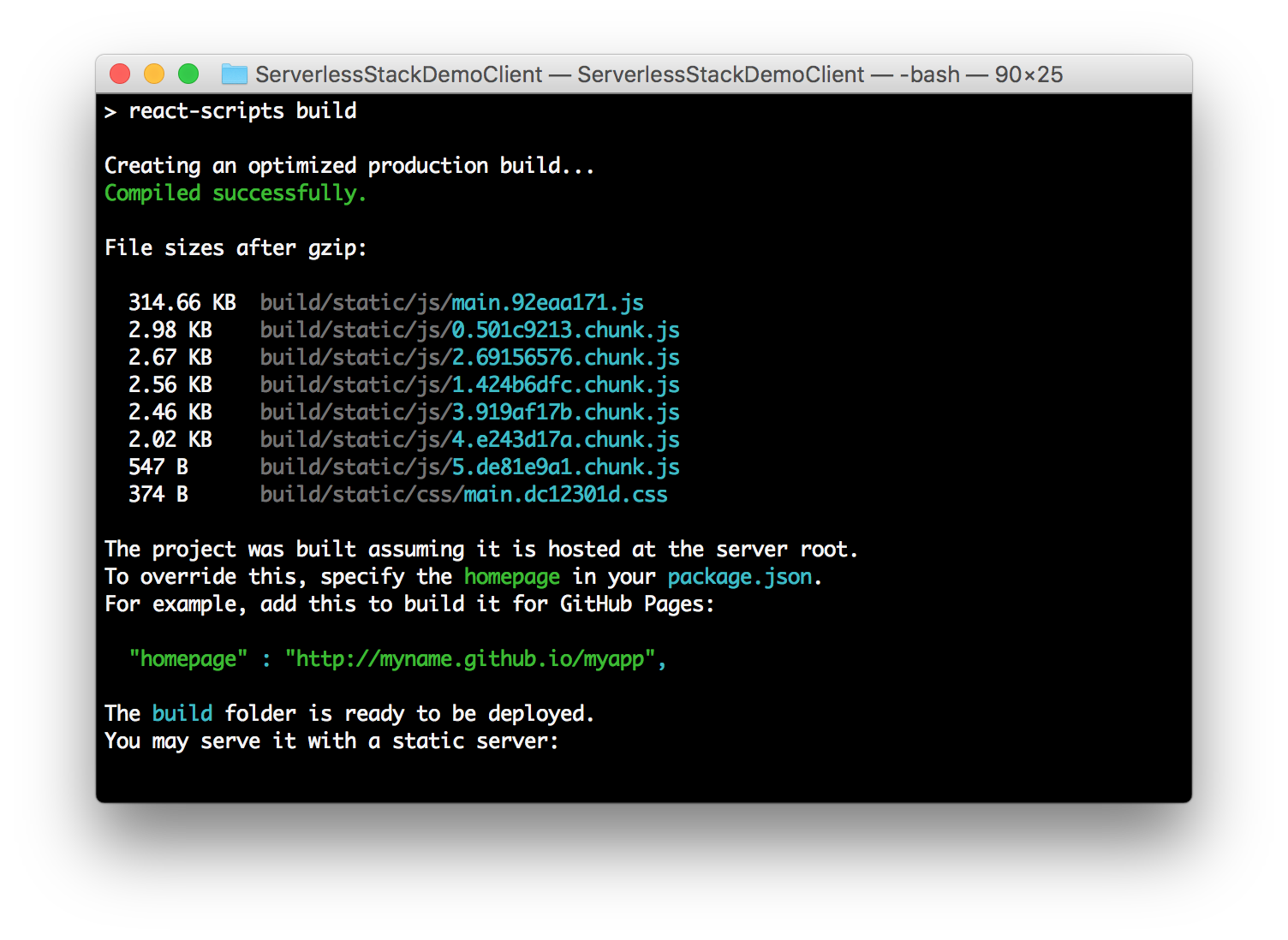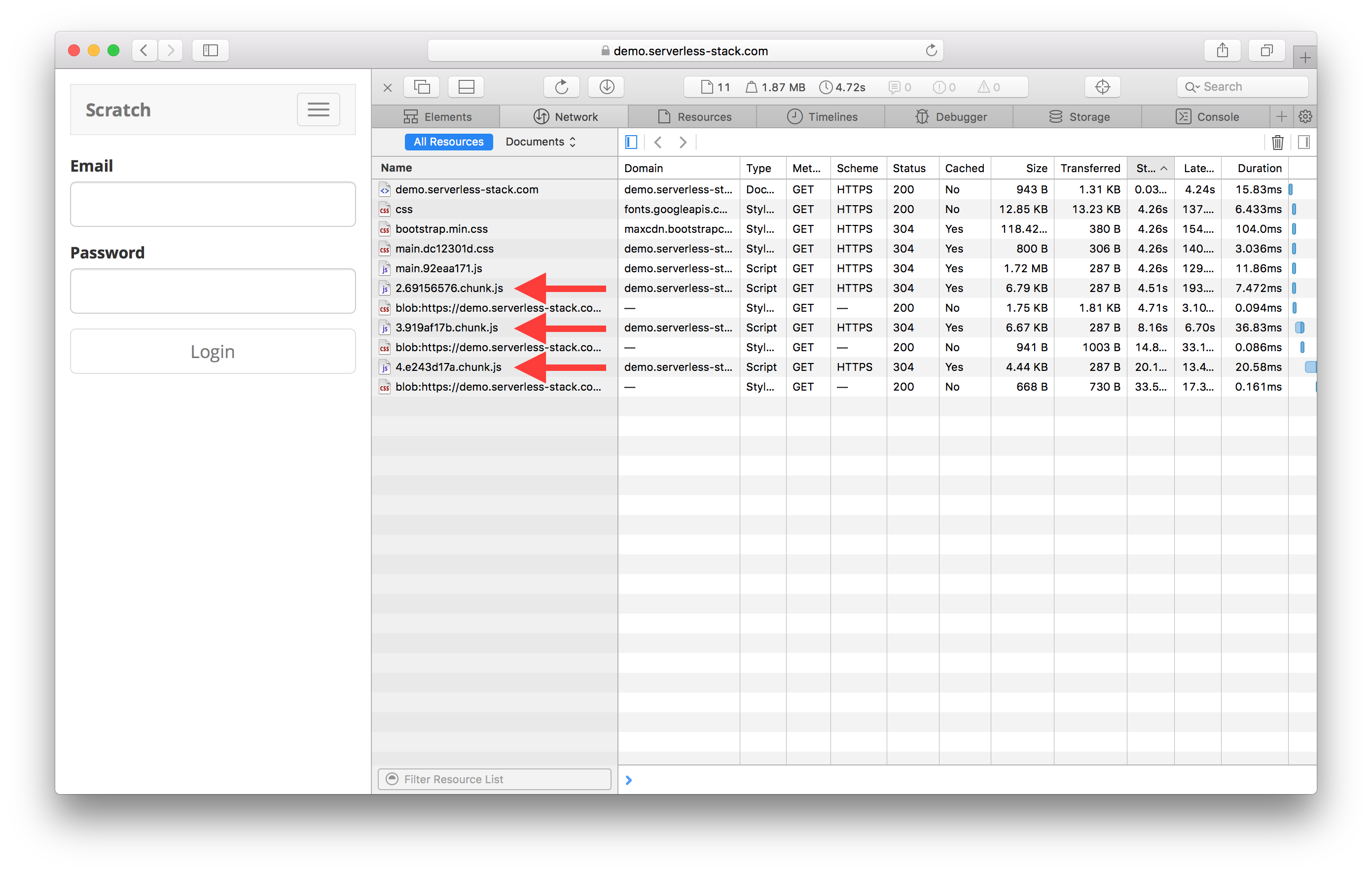Code Splitting in Create React App
Code Splitting is not a necessary step for building React apps. But feel free to follow along if you are curious about what Code Splitting is and how it can help larger React apps.
Code Splitting
While working on React.js single page apps, there is a tendency for apps to grow quite large. A section of the app (or route) might import a large number of components that are not necessary when it first loads. This hurts the initial load time of our app.
You might have noticed that Create React App will generate one large .js file while we are building our app. This contains all the JavaScript our app needs. But if a user is simply loading the login page to sign in; it doesn’t make sense that we load the rest of the app with it. This isn’t a concern early on when our app is quite small but it becomes an issue down the road. To address this, Create React App has a very simple built-in way to split up our code. This feature unsurprisingly, is called Code Splitting.
Create React App (from 1.0 onwards) allows us to dynamically import parts of our app using the import() proposal. You can read more about it here.
While, the dynamic import() can be used for any component in our React app; it works really well with React Router. Since, React Router is figuring out which component to load based on the path; it would make sense that we dynamically import those components only when we navigate to them.
Code Splitting and React Router v5
The usual structure used by React Router to set up routing for your app looks something like this.
/* Import the components */
import Home from "./containers/Home";
import Posts from "./containers/Posts";
import NotFound from "./containers/NotFound";
/* Use components to define routes */
export default () => (
<Switch>
<Route path="/" exact component={Home} />
<Route path="/posts/:id" exact component={Posts} />
<Route component={NotFound} />
</Switch>
);
We start by importing the components that will respond to our routes. And then use them to define our routes. The Switch component renders the route that matches the path.
However, we import all of the components in the route statically at the top. This means, that all these components are loaded regardless of which route is matched. To implement Code Splitting here we are going to want to only load the component that responds to the matched route.
Create an Async Component
To do this we are going to dynamically import the required component.
 Add the following to
Add the following to src/components/AsyncComponent.js.
import React, { Component } from "react";
export default function asyncComponent(importComponent) {
class AsyncComponent extends Component {
constructor(props) {
super(props);
this.state = {
component: null,
};
}
async componentDidMount() {
const { default: component } = await importComponent();
this.setState({
component: component,
});
}
render() {
const C = this.state.component;
return C ? <C {...this.props} /> : null;
}
}
return AsyncComponent;
}
We are doing a few things here:
- The
asyncComponentfunction takes an argument; a function (importComponent) that when called will dynamically import a given component. This will make more sense below when we useasyncComponent. - On
componentDidMount, we simply call theimportComponentfunction that is passed in. And save the dynamically loaded component in the state. - Finally, we conditionally render the component if it has completed loading. If not we simply render
null. But instead of renderingnull, you could render a loading spinner. This would give the user some feedback while a part of your app is still loading.
Use the Async Component
Now let’s use this component in our routes. Instead of statically importing our component.
import Home from "./containers/Home";
We are going to use the asyncComponent to dynamically import the component we want.
const AsyncHome = asyncComponent(() => import("./containers/Home"));
It’s important to note that we are not doing an import here. We are only passing in a function to asyncComponent that will dynamically import() when the AsyncHome component is created.
Also, it might seem weird that we are passing a function here. Why not just pass in a string (say ./containers/Home) and then do the dynamic import() inside the AsyncComponent? This is because we want to explicitly state the component we are dynamically importing. Webpack splits our app based on this. It looks at these imports and generates the required parts (or chunks). This was pointed out by @wSokra and @dan_abramov.
We are then going to use the AsyncHome component in our routes. React Router will create the AsyncHome component when the route is matched and that will in turn dynamically import the Home component and continue just like before.
<Route path="/" exact component={AsyncHome} />
Now let’s go back to our Notes project and apply these changes.
 Your
Your src/Routes.js should look like this after the changes.
import React from "react";
import { Route, Switch } from "react-router-dom";
import asyncComponent from "./components/AsyncComponent";
import AppliedRoute from "./components/AppliedRoute";
import AuthenticatedRoute from "./components/AuthenticatedRoute";
import UnauthenticatedRoute from "./components/UnauthenticatedRoute";
const AsyncHome = asyncComponent(() => import("./containers/Home"));
const AsyncLogin = asyncComponent(() => import("./containers/Login"));
const AsyncNotes = asyncComponent(() => import("./containers/Notes"));
const AsyncSignup = asyncComponent(() => import("./containers/Signup"));
const AsyncNewNote = asyncComponent(() => import("./containers/NewNote"));
const AsyncNotFound = asyncComponent(() => import("./containers/NotFound"));
export default ({ childProps }) => (
<Switch>
<AppliedRoute path="/" exact component={AsyncHome} props={childProps} />
<UnauthenticatedRoute
path="/login"
exact
component={AsyncLogin}
props={childProps}
/>
<UnauthenticatedRoute
path="/signup"
exact
component={AsyncSignup}
props={childProps}
/>
<AuthenticatedRoute
path="/notes/new"
exact
component={AsyncNewNote}
props={childProps}
/>
<AuthenticatedRoute
path="/notes/:id"
exact
component={AsyncNotes}
props={childProps}
/>
{/* Finally, catch all unmatched routes */}
<Route component={AsyncNotFound} />
</Switch>
);
It is pretty cool that with just a couple of changes, our app is all set up for code splitting. And without adding a whole lot more complexity either! Here is what our src/Routes.js looked like before.
import React from "react";
import { Route, Switch } from "react-router-dom";
import AppliedRoute from "./components/AppliedRoute";
import AuthenticatedRoute from "./components/AuthenticatedRoute";
import UnauthenticatedRoute from "./components/UnauthenticatedRoute";
import Home from "./containers/Home";
import Login from "./containers/Login";
import Notes from "./containers/Notes";
import Signup from "./containers/Signup";
import NewNote from "./containers/NewNote";
import NotFound from "./containers/NotFound";
export default ({ childProps }) => (
<Switch>
<AppliedRoute path="/" exact component={Home} props={childProps} />
<UnauthenticatedRoute
path="/login"
exact
component={Login}
props={childProps}
/>
<UnauthenticatedRoute
path="/signup"
exact
component={Signup}
props={childProps}
/>
<AuthenticatedRoute
path="/notes/new"
exact
component={NewNote}
props={childProps}
/>
<AuthenticatedRoute
path="/notes/:id"
exact
component={Notes}
props={childProps}
/>
{/* Finally, catch all unmatched routes */}
<Route component={NotFound} />
</Switch>
);
Notice that instead of doing the static imports for all the containers at the top, we are creating these functions that are going to do the dynamic imports for us when necessary.
Now if you build your app using npm run build; you’ll see the code splitting in action.

Each of those .chunk.js files are the different dynamic import() calls that we have. Of course, our app is quite small and the various parts that are split up are not significant at all. However, if the page that we use to edit our note included a rich text editor; you can imagine how that would grow in size. And it would unfortunately affect the initial load time of our app.
Now if we deploy our app using npx sst deploy; you can see the browser load the different chunks on-demand as we browse around in the demo.

That’s it! With just a few simple changes our app is completely set up to use the code splitting feature that Create React App has.
Next Steps
Now this seems really easy to implement but you might be wondering what happens if the request to import the new component takes too long, or fails. Or maybe you want to preload certain components. For example, a user is on your login page about to login and you want to preload the homepage.
It was mentioned above that you can add a loading spinner while the import is in progress. But we can take it a step further and address some of these edge cases. There is an excellent higher order component that does a lot of this well; it’s called react-loadable.
All you need to do to use it is install it.
$ npm install --save react-loadable
Use it instead of the asyncComponent that we had above.
const AsyncHome = Loadable({
loader: () => import("./containers/Home"),
loading: MyLoadingComponent,
});
And AsyncHome is used exactly as before. Here the MyLoadingComponent would look something like this.
const MyLoadingComponent = ({ isLoading, error }) => {
// Handle the loading state
if (isLoading) {
return <div>Loading...</div>;
}
// Handle the error state
else if (error) {
return <div>Sorry, there was a problem loading the page.</div>;
} else {
return null;
}
};
It’s a simple component that handles all the different edge cases gracefully.
To add preloading and to further customize this; make sure to check out the other options and features that react-loadable has. And have fun code splitting!
For help and discussion
Comments on this chapter

